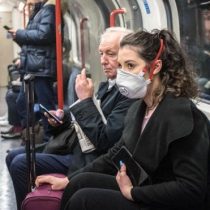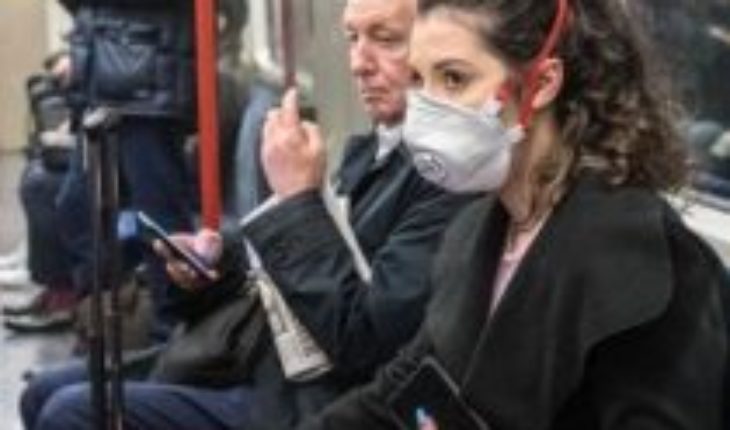
In the face of the constant expansion of covid-19, some governments are beginning to impose restrictions on people’s movement in an attempt to contain their spread.
But also, many individuals have started to take precautions on their own, for fear of contagion.
In this context, how dangerous is it really to move around the city or travel to another on a public transport?
Buses and underground trains
It is not yet known exactly how the coronavirus spreads. But one is known to spread similar viruses by inhaling droplets expelled by the cough or sneezing of an infected person, or touching surfaces contaminated with these droplets.
It is thought that coronavirus probably does not remain in the air in the same way as the flu. Therefore, one needs to be in close contact with another person to get it.
Italy extends coronavirus quarantine across country
The British National Health Service (NHS) defines “close contact” as being within a radius of at least two metres from an infected person for more than 15 minutes.
For this reason, the potential risk of becoming infected on a train or bus depends on how crowded they are and this obviously varies depending on the schedule and the area.
If possible avoid rush hour, to travel when the subway is most empty. According to a study published in 2018 that took the London Underground as an example, there is a close relationship between the use of the underground and the possibility of catching respiratory diseases.
Lara Gosce, the research author of the Global Health Institute, says the results showed that people who used the subway service were often more vulnerable to symptoms of the type that causes the flu.
“It shows in particular that neighborhoods with fewer lines—where people are forced to change subways one or more times—the rate of diseases like the flu is higher, compared to the areas with better service, where passengers can reach their destination with a direct journey,” she says.
If you travel on a relatively empty train or bus, the risks are different.
“We are dealing with epidemics like coronavirus in the wrong way”
It is also important how well ventilated the vehicles are and how much time one spends inside them.
“Limiting the number of close encounters with potentially infected people and objects is important,” says Gosce.
The problem is not only people who sneeze or cough (if infected) but also surfaces such as handles, which may become contaminated.” In terms of travel, avoid travel at rush hour as possible,” he says, adding that, if there is an option, it is better to choose a route that involves only one means of transport.
David Nabarro, special adviser on the World Health Organization coronavirus, told the BBC that while transport was something to consider, the evidence suggested that that sort of “fleeting contact” when traveling with other people did not seem to be at the moment the ” most important source of transmission.”
Aircraft
It is commonly believed that there is a better chance of getting sick on a plane because there is “stagnant” air.
In fact, the air on an airplane can be of better quality than in an average office (and almost certainly better than a train or bus).
Which countries in Latin America the coronavirus has reached and what measures have been taken
Although there are more people per square meter on a full plane, the air is changed at a faster rate.
Quingyan Chen, a professor at Purdue University in the United States, who researches air quality in different passenger vehicles, estimates that air in an aircraft is completely changed every 2-3 minutes, compared to an air-conditioned building where it changes every 10-12 minutes.
According to one study, the air inside the cockpit of an aircraft is less flawed than that of a typical office. That’s because when you’re on an airplane, the air you breathe is cleaned with the so-called high-efficiency air particle filter (Hepa).
This system can capture particles smaller than traditional air conditioning systems, including viruses.
The filter absorbs fresh air from the outside and mixes it with the air in the cabin. That means that, at all times, half the air is fresh and the other half is not.
Many traditional air conditioning systems simply recirculate the same air to save energy.
10 good news about coronavirus (like there are already 8 vaccine projects)
In addition to sucking in the droplets expelled by an infected person, another route of transmission is by contact with contaminated surfaces (it can be a person’s hand, a door handle, etc.).
Vicki Hertzberg of Emory University in the US took surface samples on 10 intercontinental flights in 2018 and discovered that they “looked like (the samples) of a house room.”
The most risky area inside an aircraft is the two rows ahead, behind and side of the infected person. In other words, there was nothing remarkable about the samples taken on a plane with the evidence he had done on buildings and other types of transport, he says.
Still, it is difficult to generalize about the risks of any form of transport because there are several factors that increase or reduce the risk.
For example, on a long flight, passengers move more. If they have the virus, there’s a better risk of spread.
According to WHO, the most risky site on a plane is the two rows in front, behind, or on the side of the infected person.
However, during the SARS (Severe Acute Respiratory Syndrome) outbreak in 2003, on a plane where an infected person was traveling, 45% of people who became infected were sitting outside this area of the plane.
It is important to follow the general recommendations: wash your hands, clean surfaces and try to sneeze or cough on a disposable handkerchief.
The main concern about air travel is, in fact, that they can transport potentially infected people from one place in the world to another.



